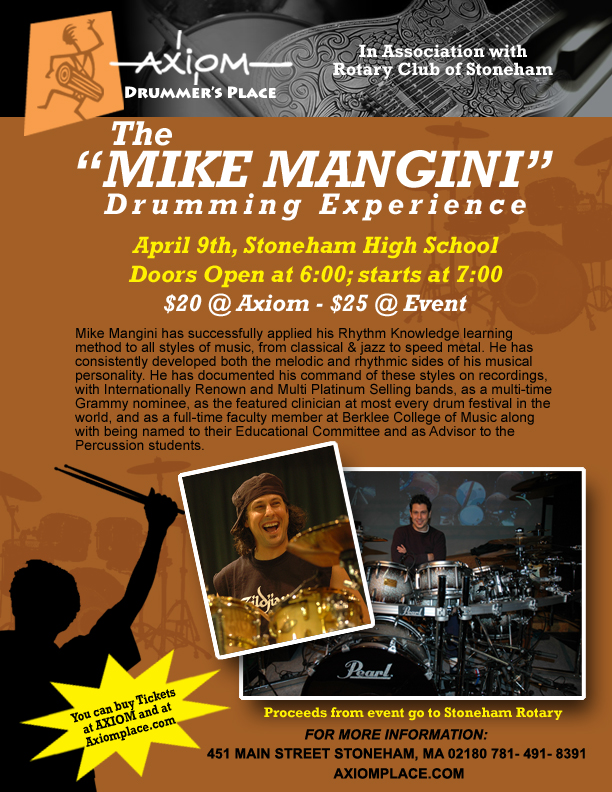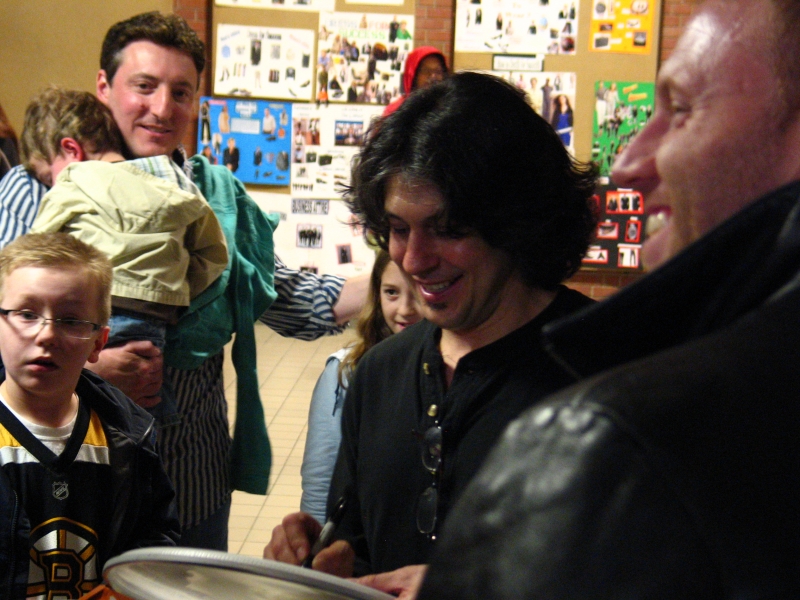 I haven’t seen Mike Mangini since I graduated Berklee in 2005, so I was very excited to see what he’s developed in the last five years. I was sure he, unlike me, had added a truckload of new tricks and concepts to his arsenal.
I haven’t seen Mike Mangini since I graduated Berklee in 2005, so I was very excited to see what he’s developed in the last five years. I was sure he, unlike me, had added a truckload of new tricks and concepts to his arsenal.
A big reason why Mike is often derided by YouTube baboons for not being “musical” is that his abilities are impressive on both a very technical and cerebral level. What often sounds like drums falling down stairs is actually something that is conceptually nothing short of astounding. So, I thought it was unfortunate that Mike had to issue a disclaimer before sitting down at the kit, stating that not everything he would be playing would be “musical”, comparing clinic drumming to a slam dunk contest, etc. The internet nonsense had already begun back when I was studying with him, but it was evident in Mike’s demeanor that it’s a worsening distraction that gnaws at him at least enough to now warrant a verbal disclaimer before taking the stage.
I’m of the opinion that if people can’t understand or appreciate what he’s doing, then, well… so what? The disclaimer should be “I’m about to blow your freaking mind. If you can’t understand what’s going on up here, I will explain. If you’re just going to right nanny-nanny-boo-boo things about me in 3rd-grade English on the Internet anyway, eat a turd and leave—in either order.” But then again, I’m not an internationally-known drum superstar with endorsements and fans that are legion…
Since I’ve mentioned endorsements, a quick description of Mike’s drum set du jour is probably in order. The kit was much more conservative than kits past, consisting of a single bass drum, three rack toms (the middle being his signature Pearl Golden Ratio snare), and a floor tom on each side. The kit remains set up in a mirror image from the center, meaning from the snare the toms descend to the left and to the right. For his feet, he had a Pearl Demon Drive double pedal, criss-crossed Pearl remote hi-hats, a pedal bracketed with a cowbell for one foot, and a pedal bracketed with a clave block for the other. Cymbals were also slightly fewer than usual but still mirrored: two hi-hats, two closed hi-hats, two rides, two crashes, one splash, two China stacks. (See the photos below.)
Before launch, Mike issued one further note of interest: he was still recovering from knee surgery he had several months ago, and this was one of the first times he would be “pushing it” since. Without a mention, it would not have been in any way evident that he was on the mend.
Mike began the solo with a heavy, slow groove punctuated with quick flourishes and dynamic shifts. He did displacements and metric modulations, eventually changing the feel between a slow shuffle and Afro-Cuban rhythms. Through many of the passages and transitions, Mike played some really tricky ostinati, which I’ll attempt to explain more in a bit. All of the familiar Mangini solo staples were mixed in: call-and-response between hands and feet; the world-record single strokes; the one-handed rim roll, complete with the “holy crap he’s only using one hand” reveal when the roll continues evenly as he raises one arm in the air. This all built to his signature climax, the four-limb singles, where single strokes with the feet are spliced between single strokes with the hands (e.g. RH-RF-LH-LF or RH-LF-LH-RF). I’ve seen no one do this as fast or as cleanly as Mike. It sounds like a Vulcan strapped atop a freight train. He started at a pretty fast clip, but got faster and more intricate with the sticking and voicing around the kit. The solo ended as it has for years, with a super-blur of crossovers and runs around the mirrored kit.
After being applauded by an audience that had no idea what it had just seen, Mike proceeded to explain some of the conceptual elements behind the solo. I have a modicum of ability to pick up patterns and odd-note-grouping stuff, but I honestly needed the explanation to figure out what was going on through most of it.
Here’s a very quick rundown of the concepts he’s added to his playing since I last saw him:
- Right-side/Left-side independence. I’m going to call this “vertical independence”, opposed to “horizontal” hands/feet independence where the feet play an ostinato and the hands solo or vice versa. Mike is now playing ostinati between, for example, his right hand and right foot while the left hand and left foot solo. This is very much the style of independence with which Marco Minnemann exploded onto the drum clinic superstar scene. Two examples:
- Clave patterns. Mike had facility with the basic left-foot clave pattern years ago, but it’s much further developed now. He’ll now play a clave ostinato with either foot and also incorporate it into the “vertical independence”. For instance, he played an Afro-Cuban rhythm between his right foot and right hand, soloing with his other two limbs.
- Right hand / Right foot Flamadiddle-diddle, i.e. fH-F-H-H-F-F. This is very much a Marco thing. I’m not sure whether the pattern was repeated or if he then mirrored it hF-H-F-F-H-H. In any case, the left hand and left foot were the soloing limbs.
Got that? Wait…
He further complicates it: he’ll create subgroupings within the larger pattern by changing sound sources within either of the groupings. Using the example above, by moving his left foot between the bass drum and hi-hat (LH-LFbd-LH-LFhh) the pattern takes twice as long to resolve!
[ADDENDUM 01.26.11 – Okay, so I didn’t get it exactly right, but I got pretty close trying to recall from memory what I saw at the clinic. Go to the end of the post to see what’s actually going on in the Expanded C&C Limb System.]

After the breakdown of his solo elements, he began a Q&A, which went on forever. Well over an hour. And most of the questions were either uninteresting or barely intelligible. Mike seemed frustrated, too, with many of the questioners. “How do you tune drums?” C’mon, this is Mike friggin’ Mangini here! I understand it’s “nice” to indulge children, but, parents, please stop using events like this as “teachable moments” to acclimate your kids to public speaking. A lot of these silly questions came from adults which was almost worse.
I’m perfectly calm…
So, with the marathon Q&A over, Mike played a tune he wrote. It was a neat, syncopated chugging guitar kind of thing with cyclic meter changes. It was heavy, technical, bad ass. But then, the clinic was over. It’s quite possible that I’m misremembering, but I recall Mike’s clinics for The Drum Pad in the early aughts being a marathon of solos and play-alongs. Maybe he’s tired of playing those tunes, maybe it was his recovering knee, or maybe the high school had a strict time limit. Regardless, I left excited and impressed, but not completely satiated.
The clinic itself was presented very well, so hats off to my buddy Libor and his school Axiom Drummer’s Place.
Here are some pics:
ADDENDUM 01.26.11
Look what I found…
Mangini Freight Train Vulcan
This is a helluva lot more face-ripping when you’re a few feet away from it, but you get the point.
Expanded C&C Limb System
Text from the video:
EXPANDED C&C: This video clip demonstrates the non-stop switching of 24 different limb pairing combinations.
In every combination, one pair is playing XOXOO and the other pair is playing XOXOXOXOXX.
Switching limb pairs on a dime with no break and without repeating any 4-limb combination is the hardest thing I’ve ever had to learn.
The purpose was to help me rebuild my balance strength after knee surgery. It is not meant to be a musical thing; it is purely a mechanical exercise.
…
The 24 limb pairings are:
(LH/RH) + (LF/RF)
(LH/RH) + (RF/LF)
(LH/LF) + (RH/RF)
(LH/LF) + (RF/RH)
(LH/RF) + (LF/RH)
(LH/RF) + (RH/LF)(LF/RF) + (LH/RH)
(LF/RF) + (RH/LH)
(LF/LH) + (RF/RH)
(LF/LH) + (RH/RF)
(LF/RH) + (LH/RF)
(LF/RH) + (RF/LH)(RH/LH) + (RF/LF)
(RH/LH) + (LF/RF)
(RH/RF) + (LH/LF)
(RH/RF) + (LF/LH)
(RH/LF) + (RF/LH)
(RH/LF) + (LH/RF)(RF/LF) + (RH/LH)
(RF/LF) + (LH/RH)
(RF/RH) + (LF/LH)
(RF/RH) + (LH/LF)
(RF/LH) + (RH/LF)
(RF/LH) + (LF/RH)












Leave a Reply